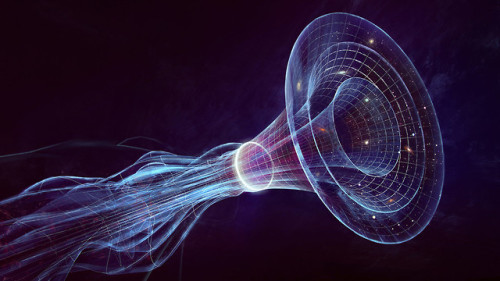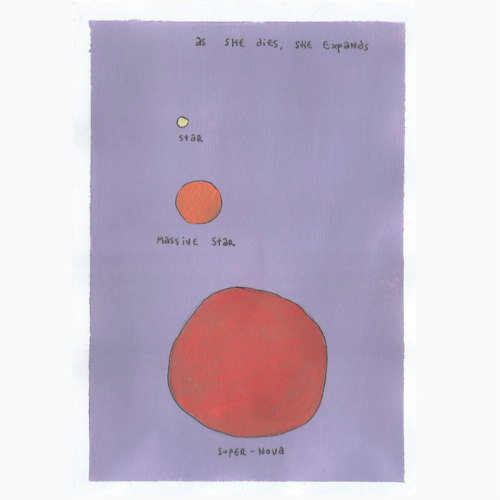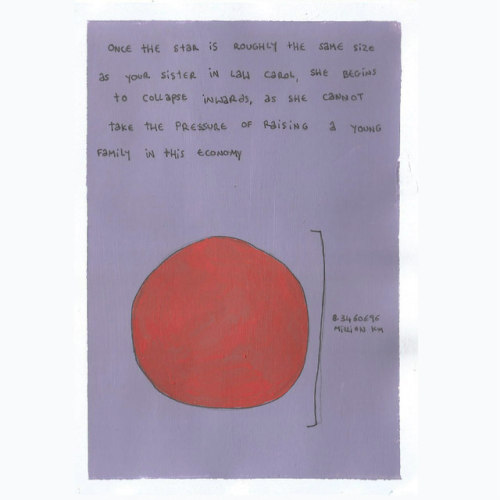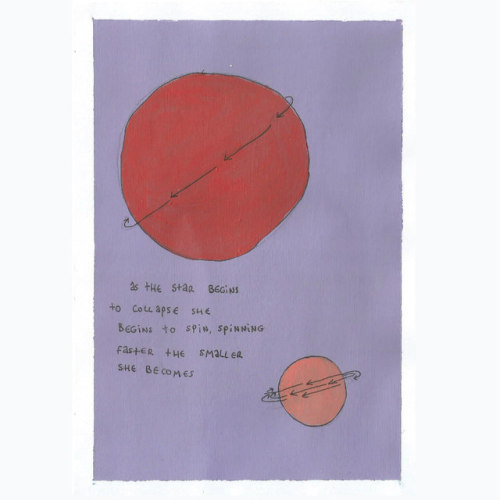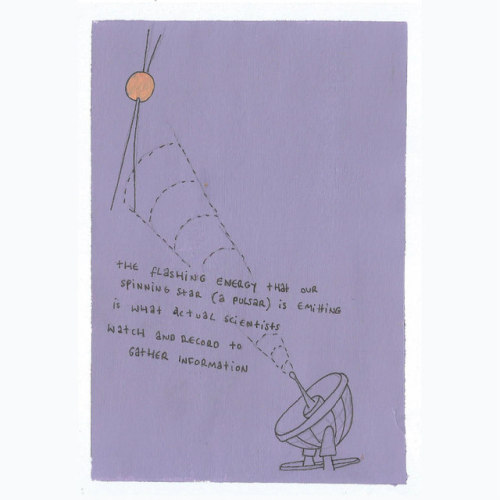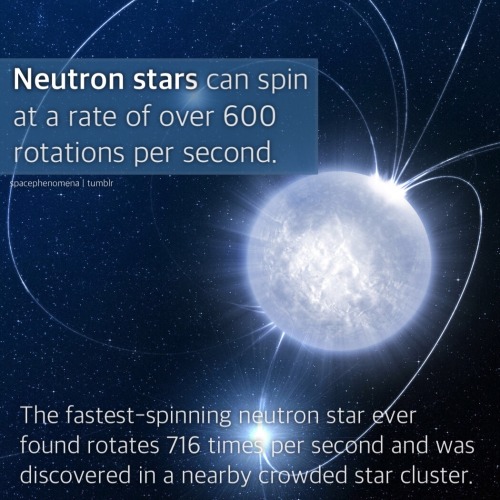#neutron star

It’s easy to get lost following the intricate, looping, twisting filaments in this detailed image of supernova remnant Simeis 147 or, as it’s better known as, the Spaghetti Nebula. Seen about 3,000 light years away, toward the boundary of the constellations Taurus and Auriga, it covers nearly 3 degrees or 6 full moons on the sky- about 150 light-years wide. This composite image includes data taken through narrow-band filters where the reddish emission is from ionized hydrogen atoms and doubly ionized oxygen atoms is in faint blue-green hues. The supernova remnant has an estimated age of about 40,000 years, meaning light from the massive stellar explosion first reached Earth 40,000 years ago. But the expanding remnant is not the only aftermath. The cosmic catastrophe also left behind a spinning neutron star, or pulsar. It’s all that remains of the original star’s core.
Happy new year everyone!
Image Credit & Copyright: Jason Dain
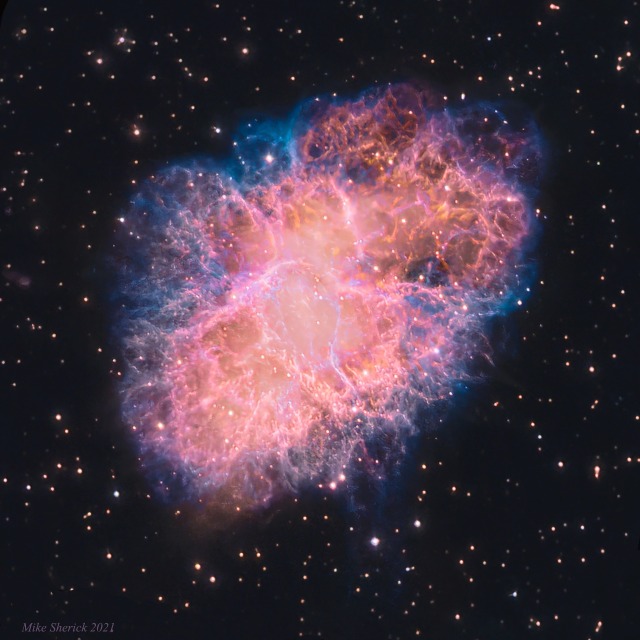
The Crab Nebula is cataloged as M1, the first object on Charles Messier’s famous 18th century list of things which are not comets. In fact, the Crab is now known to be a supernova remnant, debris from the death explosion of a massive star, witnessed by astronomers in the year 1054. This sharp, ground-based telescopic view combines broadband color data with narrowband data that tracks the emissions from ionized sulfur, hydrogen, and oxygen atoms to explore the tangled filaments within the still expanding cloud. One of the most exotic objects known to modern astronomers, the Crab Pulsar, a neutron star spinning 30 times a second, is visible as a bright spot near the nebula’s center. Like a cosmic dynamo, this collapsed remnant of the stellar core powers the Crab’s emission across the electromagnetic spectrum. Spanning about 12 light-years, the Crab Nebula is a mere 6,500 light-years away in the constellation Taurus.
Image Credit & Copyright: Michael Sherick

Neutron Star, uncredited art from The Mysterious Universe (Nigel Henbest, 1981)
The Extraordinary Core of a Neutron Star
Lucy Reading-Ikkanda/Quanta Magazine; Source: Feryal Özel
Post link
Squishy or Solid? A Neutron Star’s Insides Open to Debate
The core of a neutron star is such an extreme environment that physicists can’t agree on what happens inside. But a new space-based experiment — and a few more colliding neutron stars — should reveal whether neutrons themselves break down.
The alerts started in the early morning of Aug. 17. Gravitational waves produced by the wreck of two neutron stars — dense cores of dead stars — had washed over Earth. The thousand-plus physicists of the Advanced Laser Interferometer Gravitational-Wave Observatory (LIGO) rushed to decode the space-time vibrations that rolled across the detectors like a drawn-out peal of thunder. Thousands of astronomers scrambled to witness the afterglow. But officially, all this activity was kept secret. The data had to be collected and analyzed, the papers written. The outside world wouldn’t know for two more months.
The strict ban put Jocelyn ReadandKaterina Chatziioannou, two members of the LIGO collaboration, in a bit of an awkward situation. In the afternoon on the 17th, the two were scheduled to lead a panel at a conference dedicated to the question of what happens under the almost unfathomable conditions in a neutron star’s interior. Their panel’s topic? What a neutron-star merger would look like. “We sort of went off at the coffee break and sat around just staring at each other,” said Read, a professor at California State University, Fullerton. “OK, how are we going to do this?”
Physicists have spent decades debating whether or not neutron stars contain new forms of matter, created when the stars break down the familiar world of protons and neutrons into new interactions between quarks or other exotic particles. Answering this question would also illuminate astronomical mysteries surrounding supernovas and the production of the universe’s heavy elements, such as gold.
In addition to watching for collisions using LIGO, astrophysicists have been busy developing creative ways to probe neutron stars from the outside. The challenge is then to infer something about the hidden layers within. But this LIGO signal and those like it — emitted as two neutron stars pirouette around their center of mass, pull on each other like taffy, and finally smash together — offers a whole new handle on the problem.
Strange Matter
A neutron star is the compressed core of a massive star — the super dense cinders left over after a supernova. It has the mass of the sun, but squeezed into a space the width of a city. As such, neutron stars are the densest reservoirs of matter in the universe — the “last stuff on the line before a black hole,” said Mark Alford, a physicist at Washington University in St. Louis.
To drill into one would bring us to the edge of modern physics. A centimeter or two of normal atoms — iron and silicon, mostly — encrusts the surface like the shiny red veneer on the universe’s densest Gobstopper. Then the atoms squeeze so close together that they lose their electrons, which fall into a shared sea. Deeper, the protons inside nuclei start turning into neutrons, which cluster so close together that they start to overlap.
But theorists argue about what happens farther in, when densities creep past two or three times higher than the density of a normal atomic nucleus. From the perspective of nuclear physics, neutron stars could just be protons and neutrons — collectively called nucleons — all the way in. “Everything can be explained by variations of nucleons,” said James Lattimer, an astrophysicist at Stony Brook University.
Other astrophysicists suspect otherwise. Nucleons aren’t elementary particles. They’re made up of three quarks. Under immense pressure, these quarks might form a new state of quark matter. “Nucleons are not billiard balls,” said David Blaschke, a physicist at the University of Wroclaw in Poland. “They are like cherries. So you can compress them a little bit, but at some point you smash them.”
But to some, the prospect of a quark jam like this is a relatively vanilla scenario. Theorists have long speculated that layers of other weird particles might arise inside a neutron star. As neutrons are jostled closer together, all that extra energy might go into creating heavier particles that contain not just the “up” and “down” quarks that exclusively make up protons and neutrons, but heavier and more exotic “strange” quarks.
For example, neutrons might be replaced by hyperons, three-quark particles that include at least one strange quark. Laboratory experiments can make hyperons, but they vanish almost immediately. Deep inside neutron stars, they might be stable for millions of years.
Alternatively, the hidden depths of neutron stars might be filled with kaons — also made with strange quarks — that collect into a single lump of matter sharing the same quantum state.
For decades, though, the field has been stuck. Theorists invent ideas about what might be going on inside neutron stars, but that environment is so extreme and unfamiliar that experiments here on Earth can’t reach the right conditions. At Brookhaven National Laboratory and CERN, for example, physicists smash together heavy nuclei like those of gold and lead. That creates a soupy state of matter made up of released quarks, known as a quark-gluon plasma. But this stuff is rarefied, not dense, and at billions or trillions of degrees, it’s far hotter than the inside of neutron star, which sits in the comparatively chilly millions.
Even the decades-old theory of quarks and nuclei — “quantum chromodynamics,” or QCD — can’t really provide answers. The computations needed to study QCD in relatively cold, dense environments are so devastatingly difficult that not even computers can calculate the results. Researchers are forced to resort to oversimplification and shortcuts.
The only other option is for astronomers to study neutron stars themselves. Unfortunately, neutron stars are distant, thus dim, and difficult to measure for anything but the very basic bulk properties. Even worse, the truly interesting physics is happening under the surface. “It’s a bit like there’s this lab that’s doing amazing things,” Alford said, “but all you’re allowed to do is see the light coming out of the window.”
With a new generation of experiments coming online, though, theorists might soon get their best look yet.
Squishy or Hard?
Whatever might be inside the core of a neutron star — loose quarks, or kaon condensates, or hyperons, or just regular old nucleons — the material must be able to hold up to the crushing weight of more than a sun’s worth of gravity. Otherwise, the star would collapse into a black hole. But different materials will compress to different degrees when squeezed by gravity’s vise, determining how heavy the star can be at a given physical size.
Stuck on the outside, astronomers work backwards to figure out what neutron stars are made of. For this purpose, it helps to know how squishy or stiff they are when squeezed. And for that, astronomers need to measure the masses and radii of various neutron stars.
In terms of mass, the most easily weighed neutron stars are pulsars: neutron stars that rotate quickly, sweeping a radio beam across Earth with each spin. About 10 percent of the 2,500 known pulsars belong to binary systems. As these pulsars move with their partners, what should be a constant tick-tock of pulses hitting Earth will vary, betraying the pulsar’s motion and its location in its orbit. And from the orbit, astronomers can use Kepler’s laws and the additional rules imposed by Einstein’s general relativity to solve for the masses of the pair.
So far, the biggest breakthrough has been the discovery of surprisingly hefty neutron stars. In 2010, a team led by Scott Ransom at the National Radio Astronomy Observatory in Virginia announced that they had measured a pulsar weighing about two solar masses — making it far bigger than any previously seen. Some people doubted whether such a neutron star could exist; that it does has had immense consequences for our understanding of how nuclei behave. “Now it’s like the most cited observational pulsar paper ever, because of the nuclear physicists,” Ransom said.
According to some neutron-star models, which hold that gravity should strongly compress neutron stars, an object at that mass should collapse all the way into a black hole. That would be bad news for kaon condensates, which would be especially squishy, and it bodes poorly for some versions of quark matter and hyperons that would also compress too much. The measurement has been confirmed with the discovery of another neutron star of two solar masses in 2013.
Radii are trickier. Astrophysicists like Feryal Özel at the University of Arizona have devised various tricks to calculate the physical size of neutron stars by observing the X-rays emitted at their surfaces. Here’s one way: You can look at the overall X-ray emission, use it to estimate the temperature of the surface, and then figure out how big the neutron star needs to be to emit the observed light (correcting for how the light bends through space-time warped by gravity). Or you can look for hot spots on the neutron star’s surface that spin in and out of view. The neutron star’s strong gravitational field will modify the pulses of light from these hot spots. And once you understand the star’s gravitational field, you can reconstruct its mass and radius.
Taken at face value, these X-ray measurements suggest that even though neutron stars can be heavy, they are on the small end of predictions: only about 20 to 22 kilometers wide, according to Özel.
Accepting that neutron stars are both small and massive “kind of locks you in, in a good way,” Özel said. Neutron stars stuffed with interacting quarks would look like this, she said, while neutron stars made up of only nucleons would have larger radii.
But Lattimer, among other critics, has reservations about the assumptions that go into the X-ray measurements, which he calls flawed. He thinks they make the radii look smaller they really are.
Both sides expect that a resolution to the dispute will soon arrive. This past June, SpaceX’s 11th resupply mission to the International Space Station brought with it a 372-kilogram box containing an X-ray telescope called the Neutron Star Interior Composition Explorer (NICER). Now taking data, NICER is designed to find the size of neutron stars by watching for hot spots on their surfaces. The experiment should produce better radii measurements of neutron stars, including pulsars that have already had their masses measured.
“We look so much forward to it,” Blaschke said. A well-measured mass and radius for even a single neutron star would knock out many possible theories of their interior structure, keeping in play only the ones that could produce that particular combination of size and weight.
And now, finally chiming in, there’s LIGO.
As a first pass, the signal that Read huddled over coffee to discuss on Aug. 17 had been processed as if it were a merger of two black holes, not two neutron stars. This wasn’t unreasonable. LIGO’s previous signals had all come from black holes, which are more tractable beasts from a computational standpoint. But this signal involved lighter objects and went on for much longer than the black hole mergers. “It’s immediately obvious that this was not the same kind of system that we were practiced on,” Read said.
When two black holes spiral together, they bleed orbital energy into space-time as gravitational waves. But in the final second or so of the new 90-second-long LIGO signal, each object did something black holes don’t do: It deformed. The pair started to stretch and squeeze each other’s matter, generating tides that stole energy from their orbits. This drove them to collide faster than they would have otherwise.
After a frantic few months of running computer simulations, Read’s group inside LIGO has released their first measurement of the effect of those tides on the signal. So far, the team can set only an upper limit — meaning the tides have a weak or even unnoticeable effect. In turn, that means that neutron stars are physically small, with their matter held very tightly around their centers and thus more resistant to getting yanked by tides. “I think the first gravitational-wave measurement is in a sense really kind of confirming the kinds of things that X-ray observations have been saying,” Read said. But this isn’t the last word. She expects that more sophisticated modeling of the same signal will yield a more precise estimate.
With NICER and LIGO both offering new ways to look at neutron-star stuff, many experts are optimistic that the next few years will provide unambiguous answers to the question of how the material stands up to gravity. But theorists like Alford caution that measuring neutron-star matter’s squishiness alone won’t fully reveal what it is.
Perhaps other signatures can say more. Ongoing observations of the rate at which neutron stars cool, for example, should let astrophysicists speculate about the particles inside them and their ability to radiate away energy. Or observations of how their spins slow over time could help determine the viscosity of their insides.
Ultimately, just knowing when dense matter changes phase and what it changes into is a worthy goal, Alford argues. “Mapping the properties of matter under different conditions,” he said, “kind of is physics.
Post link
Colliding Neutron Stars Could Settle Cosmology’s Biggest Controversy
Newly discovered “standard sirens” provide an independent, clean way to measure how fast the universe is expanding.
To many cosmologists, the best thing about neutron-star mergers is that these events scream into space an otherwise close-kept secret of the universe. Scientists combined the gravitational and electromagnetic signals from the recently detected collision of two of these stars to determine, in a cleaner way than with other approaches, how fast the fabric of the universe is expanding — a much-contested number called the Hubble constant.
In the days since the neutron-star collision was announced, Hubble experts have been surprised to find themselves discussing not whether events like it could settle the controversy, but how soon they might do so.
Scientists have hotly debated the cosmic expansion rate ever since 1929, when the American astronomer Edwin Hubble first established that the universe is expanding — and that it therefore had a beginning. How fast it expands reflects what’s in it (since matter, dark energy and radiation push and pull in different ways) and how old it is, making the value of the Hubble constant crucial for understanding the rest of cosmology.
And yet the two most precise ways of measuring it result in different answers, with a curious 8 percent discrepancy that “is currently the biggest tension in cosmology,” said Dan Scolnic of the University of Chicago’s Kavli Institute for Cosmological Physics. The mismatch could be a clue that cosmologists aren’t taking into account important details that have affected the universe’s evolution. But to see if that’s the case, they need an independent check on the measurements.
Neutron-star collisions — newly detectable by the Laser Interferometer Gravitational-Wave Observatory (LIGO) and Virgo detectors — seem to be just the thing.
“This first [collision] gives us a seat at the cosmology table,” Daniel Holz, an astrophysicist with the University of Chicago and LIGO who was centrally involved in the new Hubble measurement, said in an email. “And as we get more, we can expect to play a major role in the field.”

In an expanding universe, the farther away an astronomical object is, the faster it recedes. The Hubble constant says how much faster. Edwin Hubble himself estimated that galaxies move away from us 500 kilometers per second faster for each additional megaparsec of distance between us and them (a megaparsec is about 3.3 million light-years). This was a gross overestimate; by the 1970s, astrophysicists favored values for the Hubble constant around either 50 or 100 kilometers per second per megaparsec, depending on their methods. As errors were eliminated, these camps met near the middle. However, in the past year and a half, the Hubble trouble has reheated. This time, 67 stands off against 73.
The higher estimate of 73 comes from observing lots of astronomical objects and estimating both distance and velocity for each one. It’s relatively easy to see how fast a star or galaxy is receding by looking at its “redshift” — a reddening in color that happens for the same reason the sound of a receding ambulance’s siren drops in pitch. Correct for an object’s “peculiar velocity,” caused by the gravitational pull of other objects in its neighborhood, and you’re left with its recessional velocity due to cosmic expansion.
Historically, however, it has proven much, much harder to measure the distance to an object — the other data point needed to calculate the Hubble constant.
To gauge how far away things are, astronomers build up rungs on a “cosmic distance ladder” in which each rung calibrates more-distant rungs. They start by deducing the distances to stars in the Milky Way using parallax — the stars’ apparent motion across the sky over the course of the year. With this information, astronomers can deduce the brightness of so-called Cepheid stars, which can be used as so-called “standard candles” because they all shine with a known intrinsic brightness. They then spot these Cepheid stars in nearby galaxies and use them to calculate how far away the galaxies must be. Next, the Cepheids are used to calibrate the distances to Type Ia supernovas — even brighter (though rarer) standard candles that can be seen in faraway galaxies.
Each jump from one rung to the next risks miscalculation. And yet, in 2016, a team known as SH0ES used the cosmic distance ladder approach to peg the Hubble constant at 73.2 with an accuracy of 2.4 percent.
However, in a paper published the same year, a team used the Planck telescope’s observations of the early universe to obtain a value of 67.8 for the current expansion rate — supposedly with 1 percent accuracy.
The Planck team started from the faint drizzle of ancient light called the cosmic microwave background (CMB), which reveals the universe as it looked at a critical moment 380,000 years after the Big Bang. The CMB snapshot depicts a simple, nearly smooth, plasma-filled young universe. Pressure waves of all different wavelengths rippled through the plasma, squeezing and stretching it and creating subtle density variations on different length scales.
At the moment recorded in the CMB, pressure waves with particular wavelengths would have undergone just the right fraction of an undulation since the Big Bang to all reach zero amplitude, momentarily disappearing and creating smooth plasma densities at their associated length scale. Meanwhile, pressure waves with other wavelengths undulated just the right amount to exactly peak in amplitude at the critical moment, stretching and squeezing the plasma to the full extent possible and creating maximum density variations at their associated scales.
These peaks and troughs in density variations at different scales, which can be picked up by telescopes like Planck and plotted as the “CMB power spectrum,” encode virtually everything about the young universe. The Hubble constant, in particular, can be reconstructed by measuring the distances between the peaks. “It’s a geometric effect,” explained Leo Stein, a theoretical physicist at the California Institute of Technology: The more the universe has expanded, the more the light from the CMB has curved through expanding space-time, and the closer together the peaks ought to appear to us.

Other properties of nature also affect how the peaks end up looking, such as the behavior of the invisible “dark energy” that infuses the fabric of the cosmos. The Planck scientists therefore had to make assumptions about all the other cosmological parameters in order to arrive at their estimate of 67 for the Hubble constant.
The similarity of the two Hubble measurements “is amazing” considering the vastly different approaches used to determine them, said Wendy Freedman, an astrophysicist at the University of Chicago and a pioneer of the cosmic distance ladder approach. And yet their margins of error don’t overlap. “The universe looks like it’s expanding about eight percent faster than you would have expected based on how it looked in its youth and how we expect it to evolve,” Adam Riess of Johns Hopkins University, who led the SH0ES team, told Scientific American last year. “We have to take this pretty darn seriously.”
The 67-versus-73 discrepancy could come down to an unknown error on one side or both. Or it might be real and significant — an indication that the Planck team’s extrapolation from the early universe to the present is missing a cosmic ingredient, one that changed the course of history and led to a faster expansion rate than otherwise expected. If a hypothesized fourth type of neutrino populated the infant universe, for instance, this would have increased the radiation pressure and affected the CMB peak widths. Or dark energy, whose repulsive pressure accelerates the universe’s expansion, might be getting denser over time.
Suddenly, neutron-star collisions have materialized to cast the deciding vote.
The crashing stars serve as “standard sirens,” as Holz and Scott Hughes of the Massachusetts Institute of Technology dubbed them in a 2005 paper, building on the work of Bernard Schutz 20 years earlier. They send rushes of ripples outward through space-time that are not dimmed by gas or dust. Because of this, the gravitational waves transmit a clean record of the strength of the collision, which allows scientists to “directly infer the distance to the source,” Holz explained. “There is no distance ladder, and no poorly understood astronomical calibrations. You listen to how loud the [collision] is, and how the sound changes with time, and you directly infer how far away it is.” Because astronomers can also detect electromagnetic light from neutron-star collisions, they can use redshift to determine how fast the merged stars are receding. Recessional velocity divided by distance gives the Hubble constant.
From the first neutron-star collision alone, Holz and hundreds of coauthors calculated the Hubble constant to be 70 kilometers per second per megaparsec, give or take 10. (The major source of uncertainty is the unknown angular orientation of the merging neutron stars relative to the LIGO detectors, which affects the measured amplitude of the signal.) Holz said, “I think it’s just pure luck that we’re smack in the middle,” between the cosmic-distance-ladder and cosmic-microwave-background Hubble estimates. “We could easily shift to one side or the other.”
The measurement’s accuracy will steadily improve as more standard sirens are heard over the next few years, especially as LIGO continues to ramp up in sensitivity. According to Holz, “With roughly 10 more events like this one, we’ll get to 1 percent [of error],” though he stresses that this is a preliminary and debatable estimate. Riess thinks it will take more like 30 standard sirens to reach that level. It all depends on how lucky LIGO and Virgo got with their first detection. “I do think the method has the potential to be a game changer,” said Freedman. “How fast this will occur [or] what the rate of these objects will be … we don’t yet know.”
Scolnic, who was part of SH0ES, said his team’s tension with Planck’s measurement is so large that “the standard siren approach doesn’t need to get to 1 percent to be interesting.”
As more standard sirens resound, they’ll gradually home in on the Hubble constant once and for all and determine whether or not the expansion rate agrees with expectations based on the young universe. Holz, for one, is exhilarated. “I’ve dedicated the last decade of my life in the hopes of making one plot: a standard siren measurement of the Hubble. I got to make my Hubble plot, and it is beautiful.”
Post link


